Effect of Grease Composition on Impact-Sliding Wear
Abstract
1. Introduction
2. Experimental Equipment and Conditions
2.1. Experimental Equipment and Principle
2.2. Experimental Materials and Parameters
3. Results and Discussion
3.1. Field-Emission Scanning Electron Microscope Images of Four Greases
3.2. Experimental Results for Yangtze Grease 1 and Yangtze Grease 2
3.3. Experimental Results of Yangtze Grease 3 and Yangtze Grease 4
4. Discussion
5. Conclusions
- A higher base oil viscosity is beneficial to prevent impact wear. Among the constituents of grease, the viscosity of the base oil is a primary determinant of its anti-wear properties. With an increase in sliding velocity, a higher base oil viscosity results in a more pronounced protective effect against impact wear.
- The content of the thickener has minimal impact on the film-forming properties of greases with lower base oil viscosity, but it has a significant effect on greases with higher base oil viscosity. At low speeds, higher thickener content reduces the central film thickness, but the effect is little at high speeds. Therefore, based on the premise of increasing the film thickness of the grease, the thickener content needs to be controlled within a reasonable range for different movement speeds.
- The size of the thickener fiber structure and the density of the entanglement structure will affect the fluidity and load-bearing capacity of the grease. Larger fiber sizes and entanglement structure densities will reduce the fluidity and recoverability of the grease but increase the load-bearing capacity. Smaller fiber sizes and entanglement structures will increase the fluidity and recoverability of the grease, but the load-bearing capacity will decrease. Additionally, smaller fiber sizes are more susceptible to the impact of sliding speed. Therefore, in order to obtain the best anti-wear performance, it is necessary to control the base oil viscosity and thickener content according to different movement speeds and control the size of the thickener fiber and the density of the entanglement structure within a reasonable range to achieve the purpose of enhancing the fluidity and load-bearing capacity of the grease.
Author Contributions
Funding
Data Availability Statement
Conflicts of Interest
References
- Christensen, H. Oil Film in a Closing Gap. Proc. R. Soc. London. Ser. A. Math. Phys. Sci. 1962, 266, 312–328. [Google Scholar] [CrossRef]
- Larsson, R.; Lundberg, J. Study of Lubricated Impact Using Optical Interferometry. Wear 1995, 190, 184–189. [Google Scholar] [CrossRef]
- Sakamoto, M.; Nishikawa, H.; Kaneta, M. Behaviour of Point Contact EHL Films under Pulsating Loads; Elsevier: Amsterdam, The Netherlands, 2003; pp. 391–399. [Google Scholar] [CrossRef]
- Guo, F.; Kaneta, M.; Wang, J.; Nishikawa, H.; Yang, P. Occurrence of a Noncentral Dimple in Squeezing EHL Contacts. J. Tribol. 2006, 128, 632–640. [Google Scholar] [CrossRef]
- Kaneta, M.; Ozaki, S.; Nishikawa, H.; Guo, F. Effects of Impact Loads on Point Contact Elastohydrodynamic Lubrication Films. Proc. Inst. Mech. Eng. Part J J. Eng. Tribol. 2007, 221, 271–278. [Google Scholar] [CrossRef]
- Nishikawa, H.; Miyazaki, H.; Kaneta, M.; Guo, F. Effects of Two-Stage Impact Load on Point Contact Elastohydrodynamic Lubrication Films. Proc. Inst. Mech. Eng. Part J J. Eng. Tribol. 2008, 222, 807–814. [Google Scholar] [CrossRef]
- Kaneta, M.; Nishikawa, H.; Mizui, M.; Guo, F. Impact Elastohydrodynamics in Point Contacts. Proc. Inst. Mech. Eng. Part J J. Eng. Tribol. 2011, 225, 1–12. [Google Scholar] [CrossRef]
- Kaneta, M.; Wang, J.; Guo, F.; Krupka, I.; Hartl, M. Effects of Loading Process and Contact Shape on Point Impact Elastohydrodynamics. Tribol. Trans. 2012, 55, 772–781. [Google Scholar] [CrossRef]
- Fryza, J.; Sperka, P.; Kaneta, M.; Krupka, I.; Hartl, M. Effects of Lubricant Rheology and Impact Speed on EHL Film Thickness at Pure Squeeze Action. Tribol. Int. 2017, 106, 1–9. [Google Scholar] [CrossRef]
- Sukpat, M.; Jirapong, K.; Karuna, T. Computational Study of Impact Wear: FatigueApproach. Wear 2023, 528–529, 204972. [Google Scholar] [CrossRef]
- Wang, S.G.; He, W.F.; Zhang, H.H.; Zhang, L.Y.; Cao, X.; Jiao, Y.; Huang, D.; Li, C.Z.; Zhang, Y.H. Study on the Impact Erosion Wear Resistance and Damage Evolution of TiN Films under Different Impact Cycles. Thin Solid Film. 2023, 770, 139757. [Google Scholar] [CrossRef]
- Chen, X.D.; Wang, L.W.; Yang, L.Y.; Tang, R.; Yu, Y.Q.; Cai, Z.B. Investigation on the Impact Wear Behavior of 2.25Cr–1Mo Steel at Elevated Temperature. Wear 2021, 476, 203740. [Google Scholar] [CrossRef]
- Yilmaz, H.; Sadeler, R. Impact Wear Behavior of Ball Burnished 316L Stainless Steel. Surf. Coat. Technol. 2019, 363, 369–378. [Google Scholar] [CrossRef]
- Wang, S.; Cui, Q.; Zou, J.; Zhang, Z. Impact Wear Mechanism of 2Cr13 Steel under Small Stress Multi-Impact Conditions. Wear 2020, 462–463, 203492. [Google Scholar] [CrossRef]
- Yin, M.; Cai, Z.; Zhang, Z.; Yue, W. Effect of Ultrasonic Surface Rolling Process on Impact-Sliding Wear Behavior of the 690 Alloy. Tribol. Int. 2020, 147, 105600. [Google Scholar] [CrossRef]
- Wang, C.; Aldakheel, F.; Zhang, C.W.; Gu, L.; Wriggers, P. Failure of High-Speed Bearing at Cyclic Impact-Sliding Contacts: Numerical and Experimental Analysis. Int. J. Mech. Sci. 2023, 253, 108410. [Google Scholar] [CrossRef]
- Lv, Z.; Han, Y.; Zhang, R.; Wang, J. Occurrence of Grease Lubricated Impact-Sliding Composite Wear. Lubricants 2022, 10, 284. [Google Scholar] [CrossRef]
- ASTM 1961 09.01; Annual Book of ASTM Standards. ASTM International: West Conshohocken, PA, USA, 2002; pp. 389–392.
- Salomonsson, L.; Stang, G.; Zhmud, B. Oil/Thickener Interactions and Rheology of Lubricating Greases. Tribol. Trans. 2007, 50, 302–309. [Google Scholar] [CrossRef]
- Spikes, H.A.; Cann, P.M. The Development and Application of the Spacer Layer Imaging Method for Measuring Lubricant Film Thickness. Proc. Inst. Mech. Eng. Part J J. Eng. Tribol. 2001, 215, 261–277. [Google Scholar] [CrossRef]
- Cann, P.M.E.; Damiens, B.; Lubrecht, A.A. The Transition between Fully Flooded and Starved Regimes in EHL. Tribol. Int. 2004, 37, 859–864. [Google Scholar] [CrossRef]
- Kanazawa, Y.; De Laurentis, N.; Kadiric, A. Studies of Friction in Grease-Lubricated Rolling Bearings Using Ball-on-Disc and Full Bearing Tests. Tribol. Trans. 2019, 63, 77–89. [Google Scholar] [CrossRef]
- Wu, M.J.; Han, X.; Tao, Y.R.; Pei, J.X. An Average Flow Model Considering Non-Newtonian Characteristics with Application to Grease Behavior. J. Tribol. 2022, 144, 101802. [Google Scholar] [CrossRef]
- Jin, X.Y.; Li, X.M.; Chen, Q.; Yang, P.; Guo, F.; Jiang, N. Observation of Grease Film Behavior in Sliding-Rolling Concentrated Contacts. J. Tribol. 2021, 144, 011602. [Google Scholar] [CrossRef]
- Cann, P.M. Starvation and Reflow in a Grease-Lubricated Elastohydrodynamic Contact. Tribol. Trans. 1996, 39, 698–704. [Google Scholar] [CrossRef]
- Cann, P.M. Understanding Grease Lubrication. Tribol. Ser. 1996, 31, 573–581. [Google Scholar] [CrossRef]
- Kimura, Y.; Endo, T.; Dong, D. EHL with Grease at Low Speeds. In Advanced Tribology; Springer: Berlin/Heidelberg, Germany, 2008; pp. 15–19. [Google Scholar] [CrossRef]
- De Laurentis, N.; Kadiric, A.; Lugt, P.; Cann, P. The Influence of Bearing Grease Composition on Friction in Rolling/Sliding Concentrated Contacts. Tribol. Int. 2016, 94, 624–632. [Google Scholar] [CrossRef]
- Cen, H.; Lugt, P.M.; Morales-Espejel, G. On the Film Thickness of Grease-Lubricated Contacts at Low Speeds. Tribol. Trans. 2014, 57, 668–678. [Google Scholar] [CrossRef]
- Cen, H.; Lugt, P.M.; Morales-Espejel, G. Film Thickness of Mechanically Worked Lubricating Grease at Very Low Speeds. Tribol. Trans. 2014, 57, 1066–1071. [Google Scholar] [CrossRef]
- Morales-Espejel, G.E.; Lugt, P.M.; Pasaribu, H.R.; Cen, H. Film Thickness in Grease Lubricated Slow Rotating Rolling Bearings. Tribol. Int. 2014, 74, 7–19. [Google Scholar] [CrossRef]
- Cyriac, F.; Lugt, P.M.; Bosman, R.; Padberg, C.J.; Venner, C.H. Effect of Thickener Particle Geometry and Concentration on the Grease EHL Film Thickness at Medium Speeds. Tribol. Lett. 2016, 61, 18. [Google Scholar] [CrossRef]
- Lugt, P.M. A Review on Grease Lubrication in Rolling Bearings. Tribol. Trans. 2009, 52, 470–480. [Google Scholar] [CrossRef]
- Cann, P.M. Grease Lubrication of Rolling Element Bearings—Role of the Grease Thickener. Lubr. Sci. 2007, 19, 183–196. [Google Scholar] [CrossRef]
- Sakai, K.; Tokumo, Y.; Ayame, Y.; Shitara, Y.; Tanaka, H.; Sugimura, J. Effect of Formulation of Li Greases on Their Flow and Ball Bearing Torque. Tribol. Online 2016, 11, 168–173. [Google Scholar] [CrossRef][Green Version]
- Couronné, I.; Vergne, P.; Mazuyer, D.; Truong-Dinh, N.; Girodin, D. Effects of Grease Composition and Structure on Film Thickness in Rolling Contact. Tribol. Trans. 2003, 46, 31–36. [Google Scholar] [CrossRef]
- Xu, N.; Wang, X.; Ma, R.; Li, W.; Zhang, M. Insights into the Rheological Behaviors and Tribological Performances of Lubricating Grease: Entangled Structure of a Fiber Thickener and Functional Groups of a Base Oil. New J. Chem. 2018, 42, 1484–1491. [Google Scholar] [CrossRef]
- Kanazawa, Y.; Sayles, R.S.; Kadiric, A. Film Formation and Friction in Grease Lubricated Rolling-Sliding Non-Conformal Contacts. Tribol. Int. 2017, 109, 505–518. [Google Scholar] [CrossRef]
- Schultheiss, H.; Tobie, T.; Stahl, K. The Effect of Selected Grease Components on the Wear Behavior of Grease-Lubricated Gears. J. Tribol. 2016, 138, 011602. [Google Scholar] [CrossRef]
- Liu, H.C.; Guo, F.; Guo, L.; Wong, P.L. A Dichromatic Interference Intensity Modulation Approach to Measurement of Lubricating Film Thickness. Tribol. Lett. 2015, 58, 15. [Google Scholar] [CrossRef]
- Han, Y.M.; Sperka, P.; Wang, J.; Krupka, I.; Hartl, M.; Li, W.M.; Wang, X.B.; Liu, W.M. InfluenceofFreeWaterDroplets on Film Formation under Point Contact-Grease-Lubrication. J. Tribol. 2023, 145, 074101. [Google Scholar] [CrossRef]

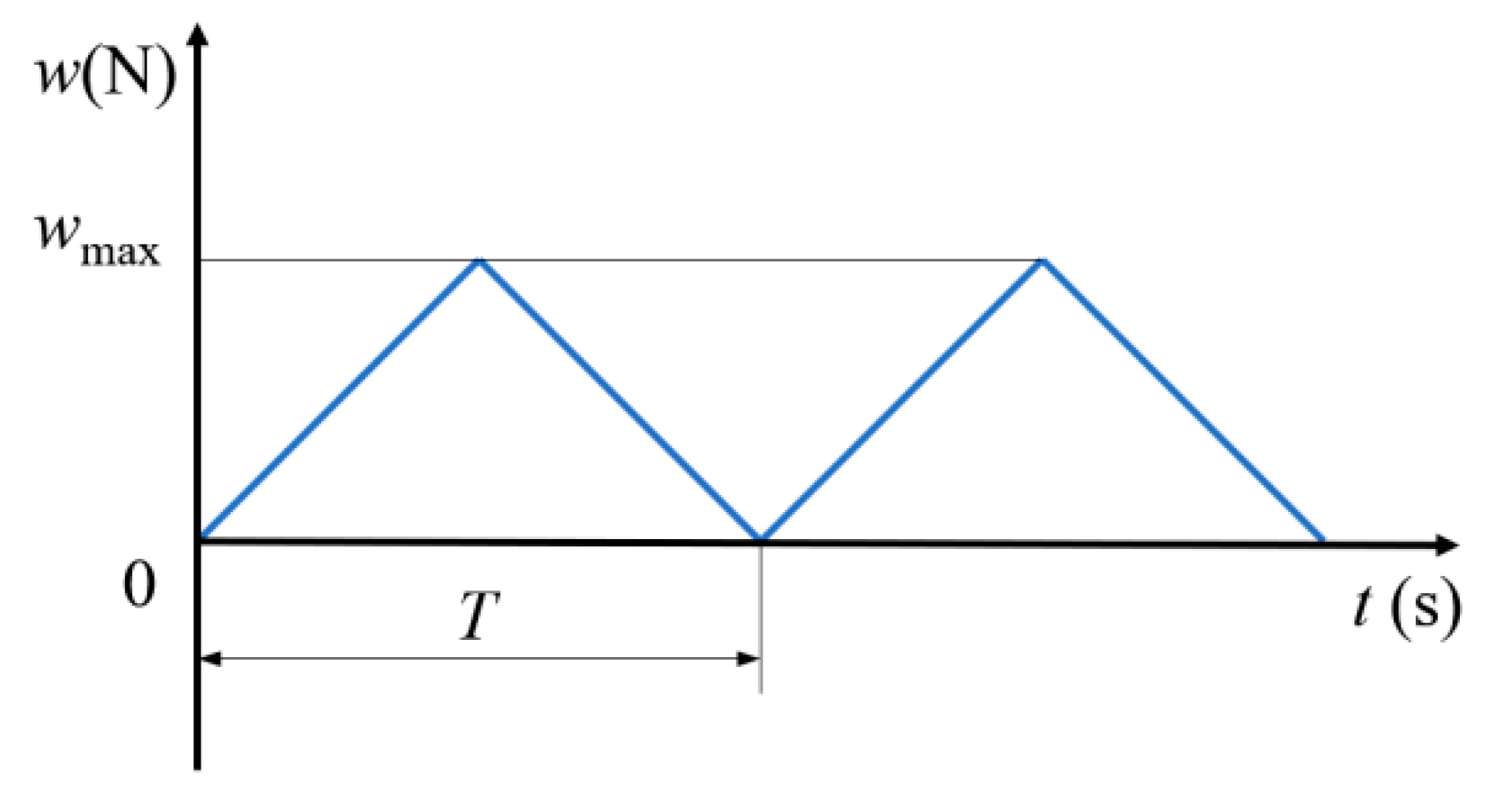
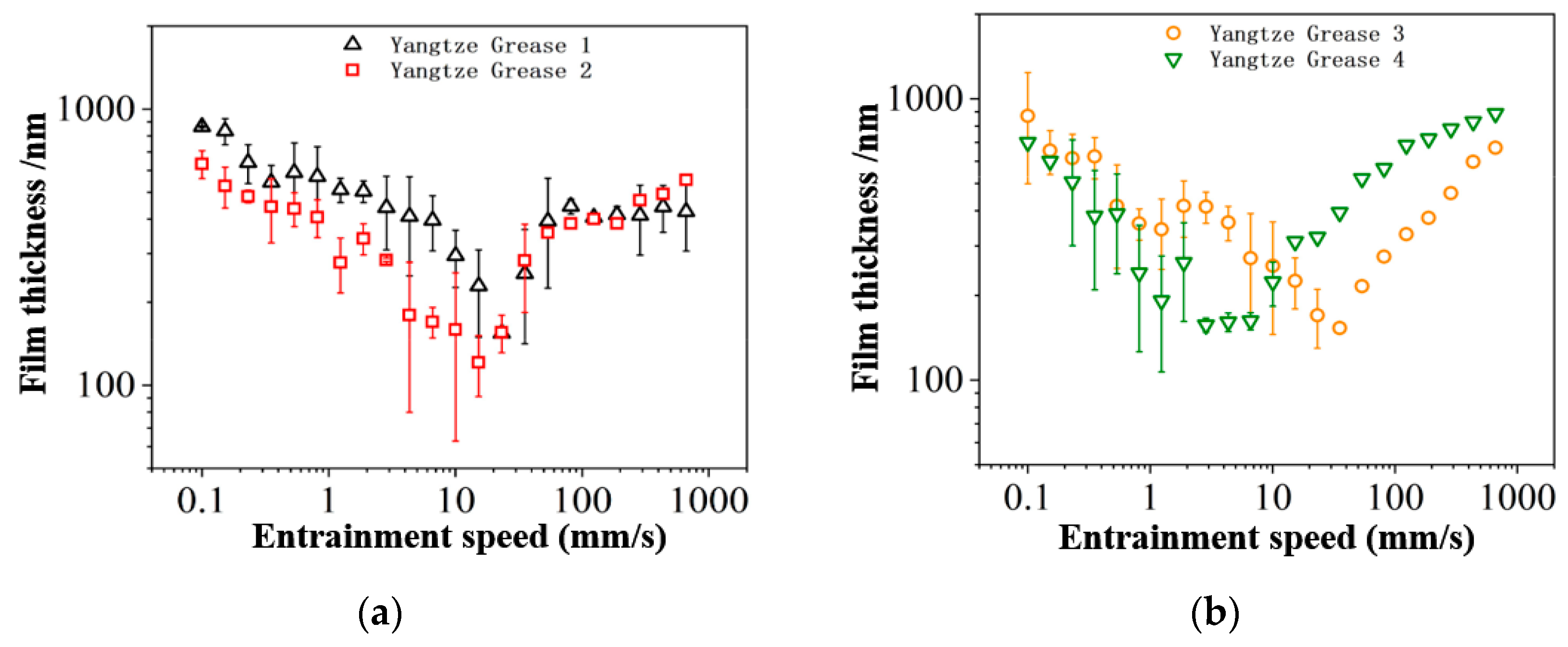

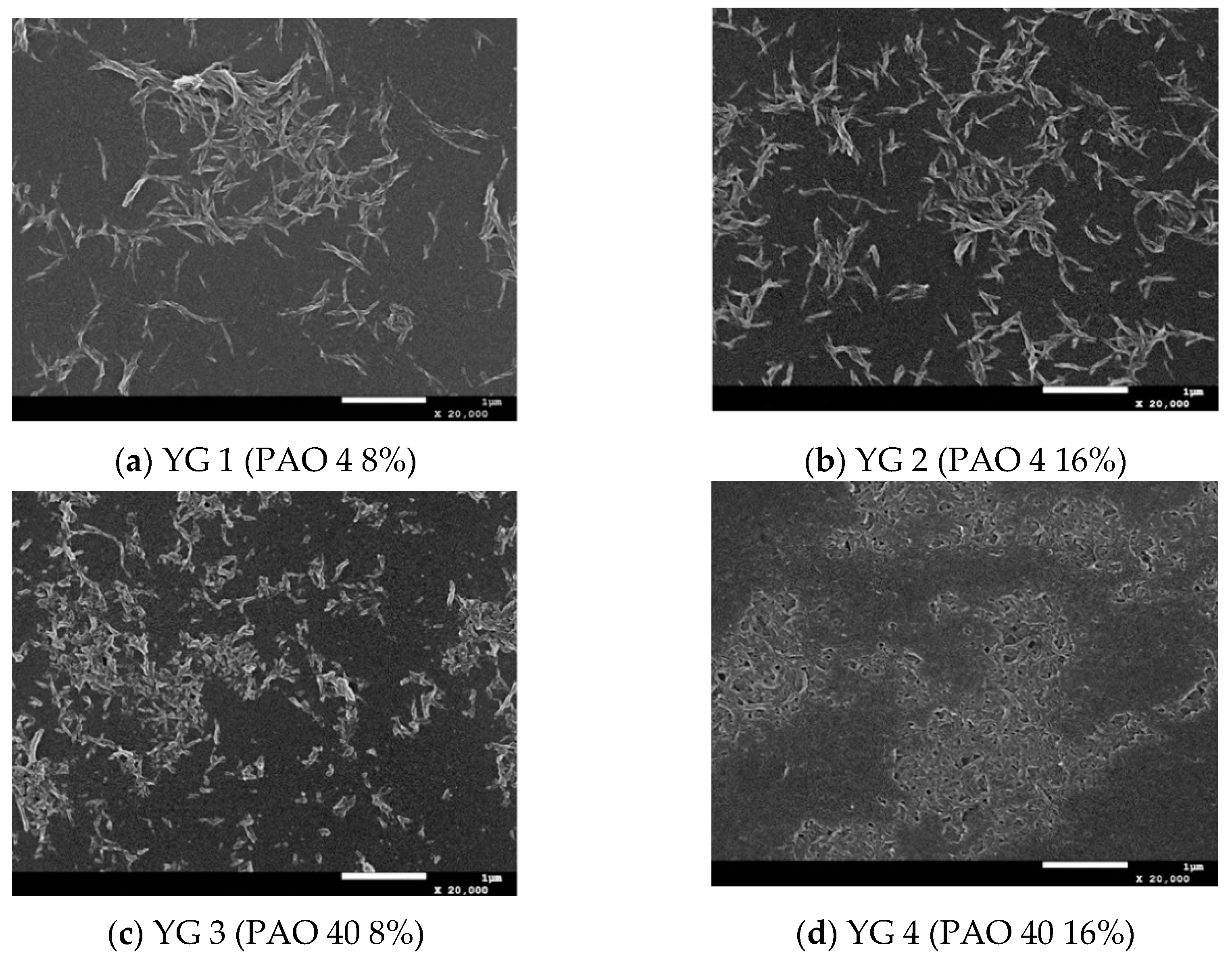

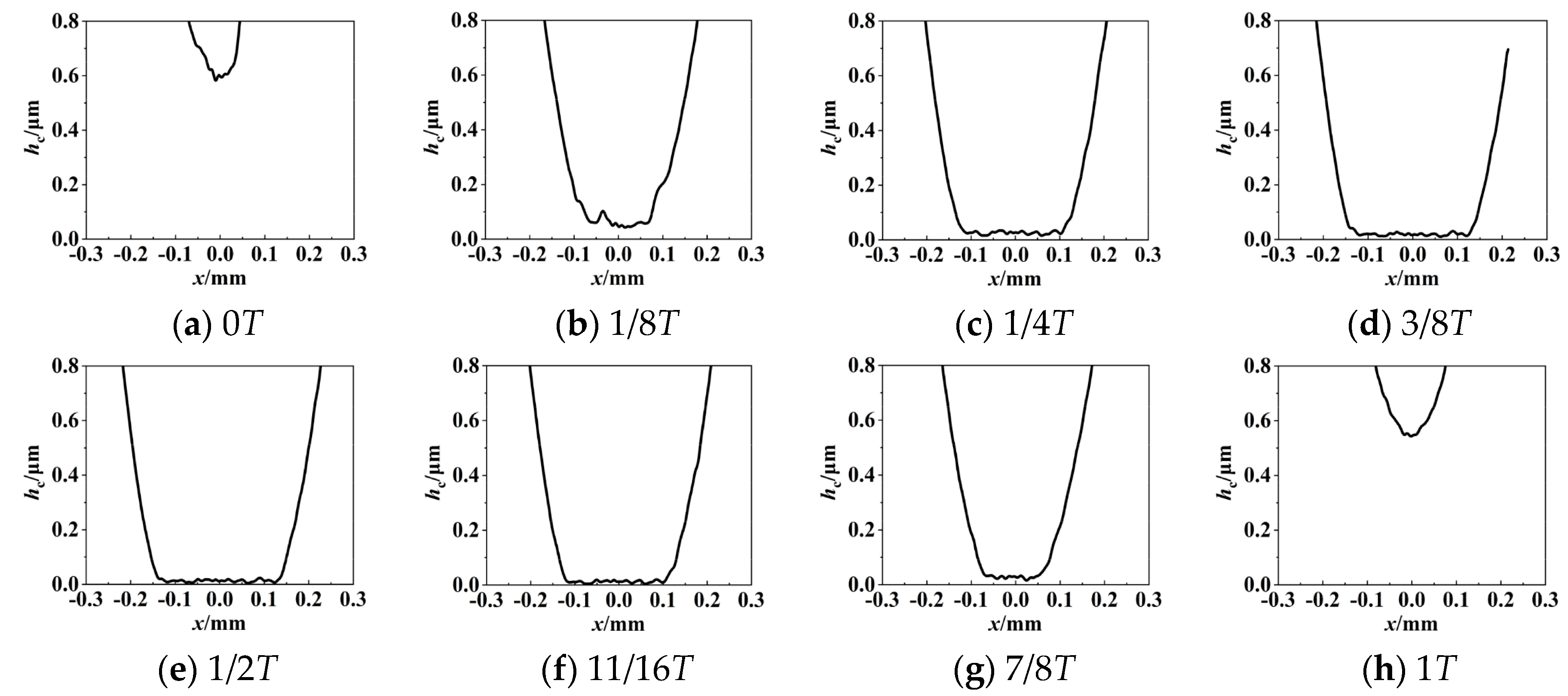



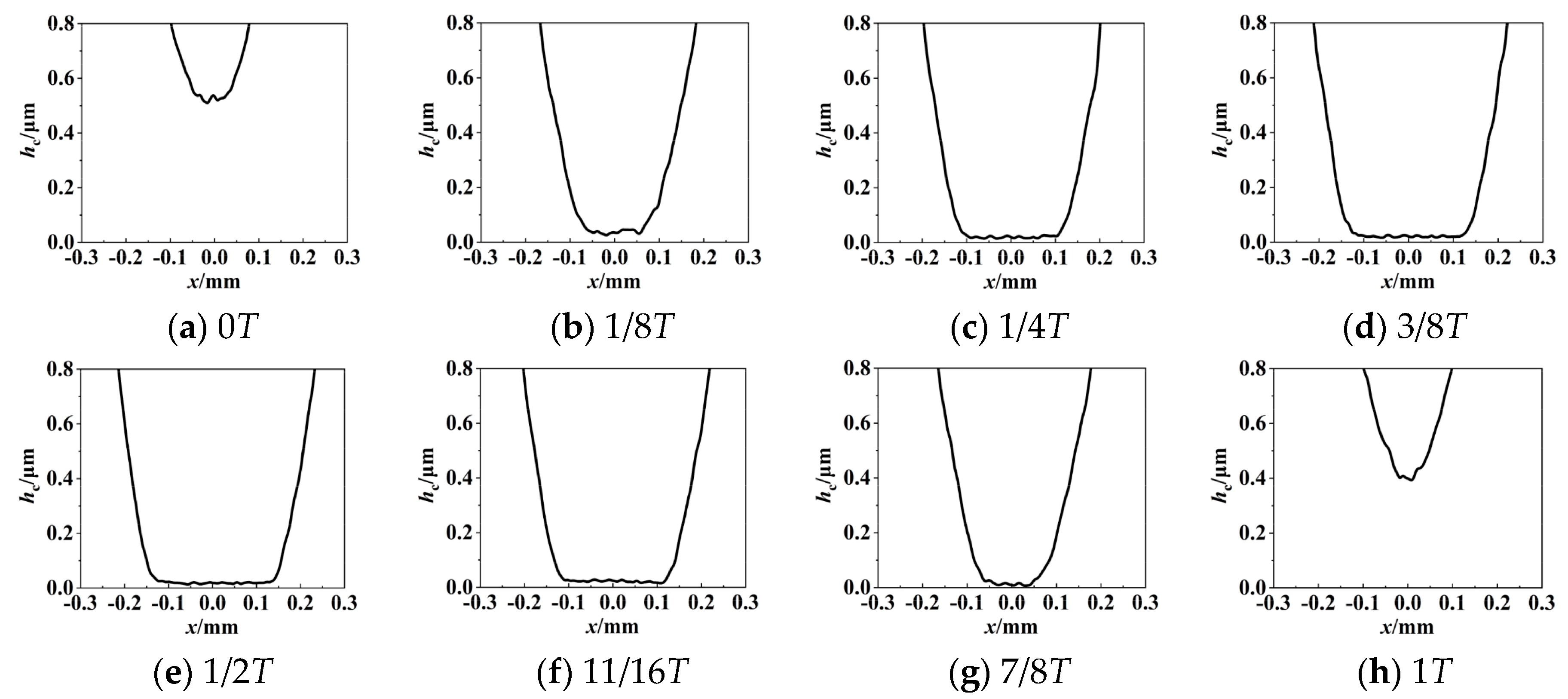
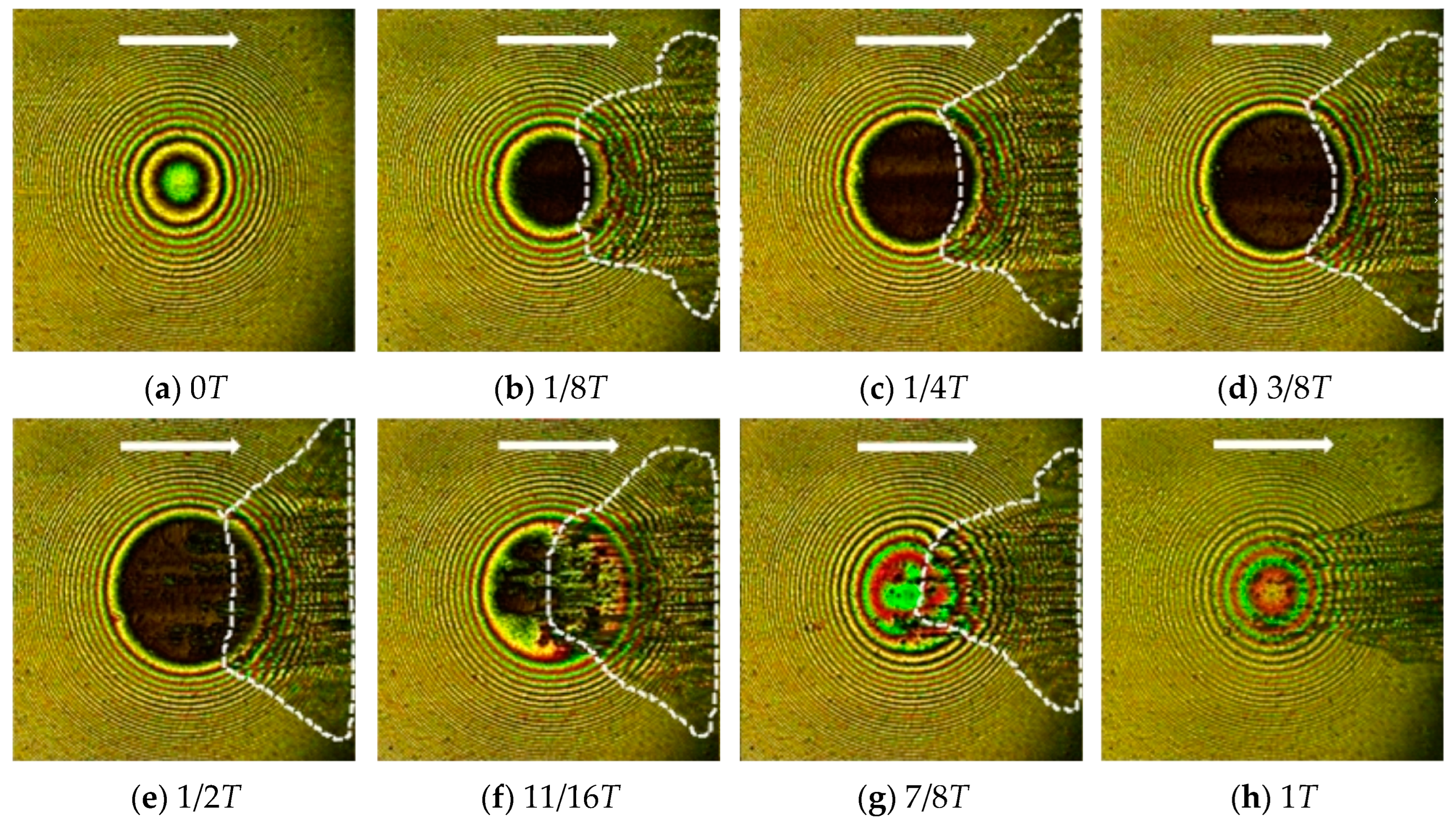

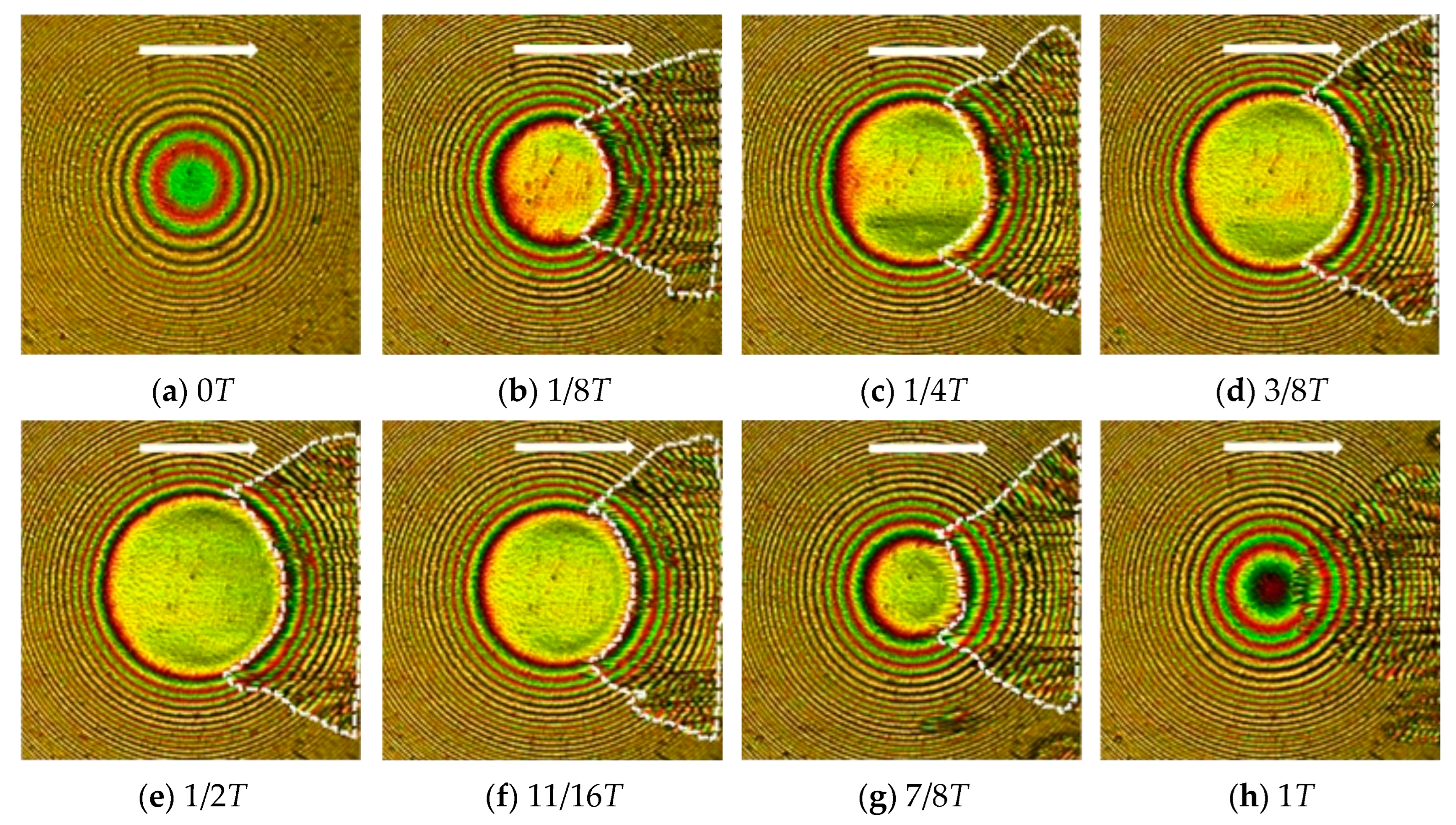

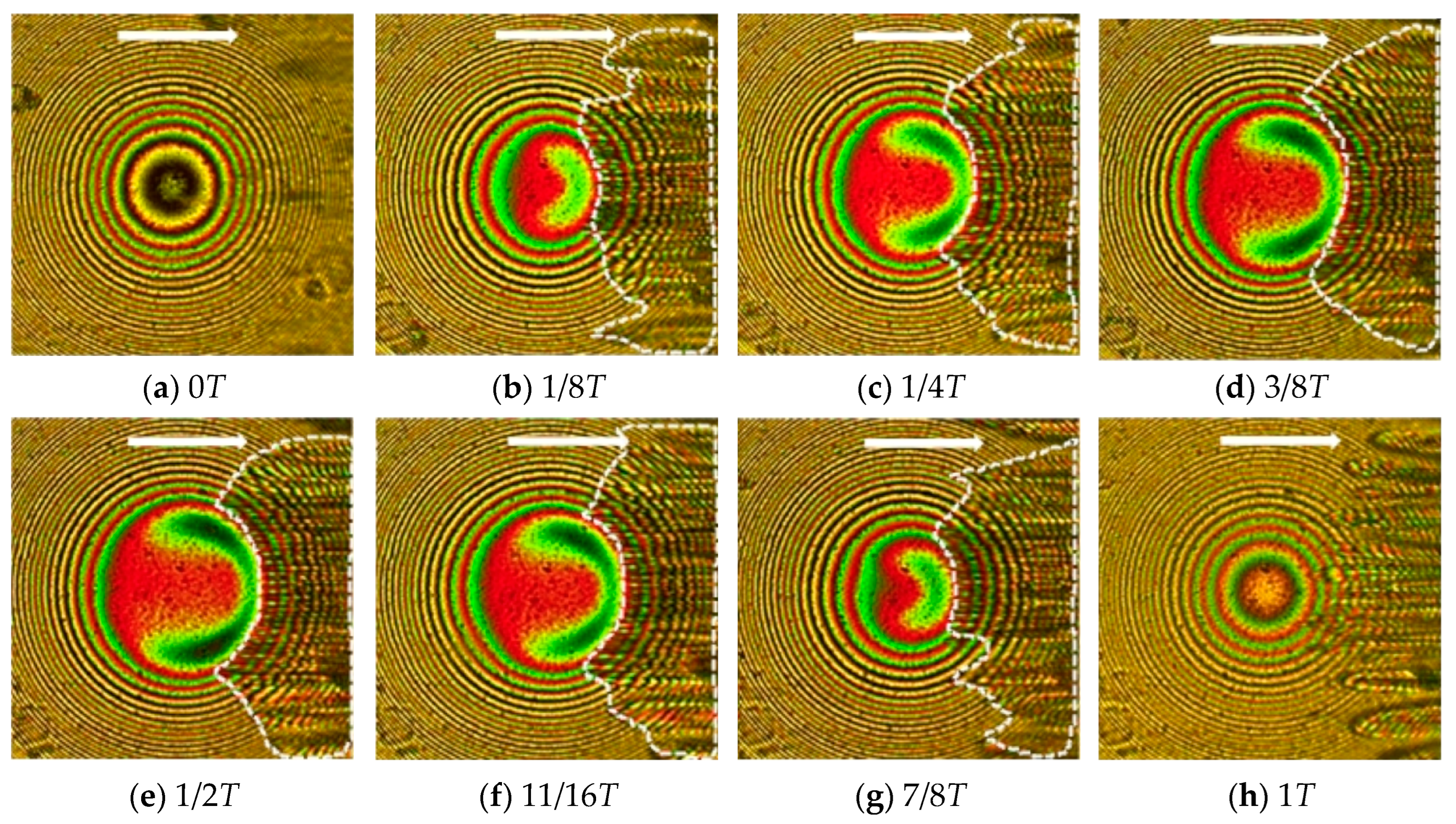
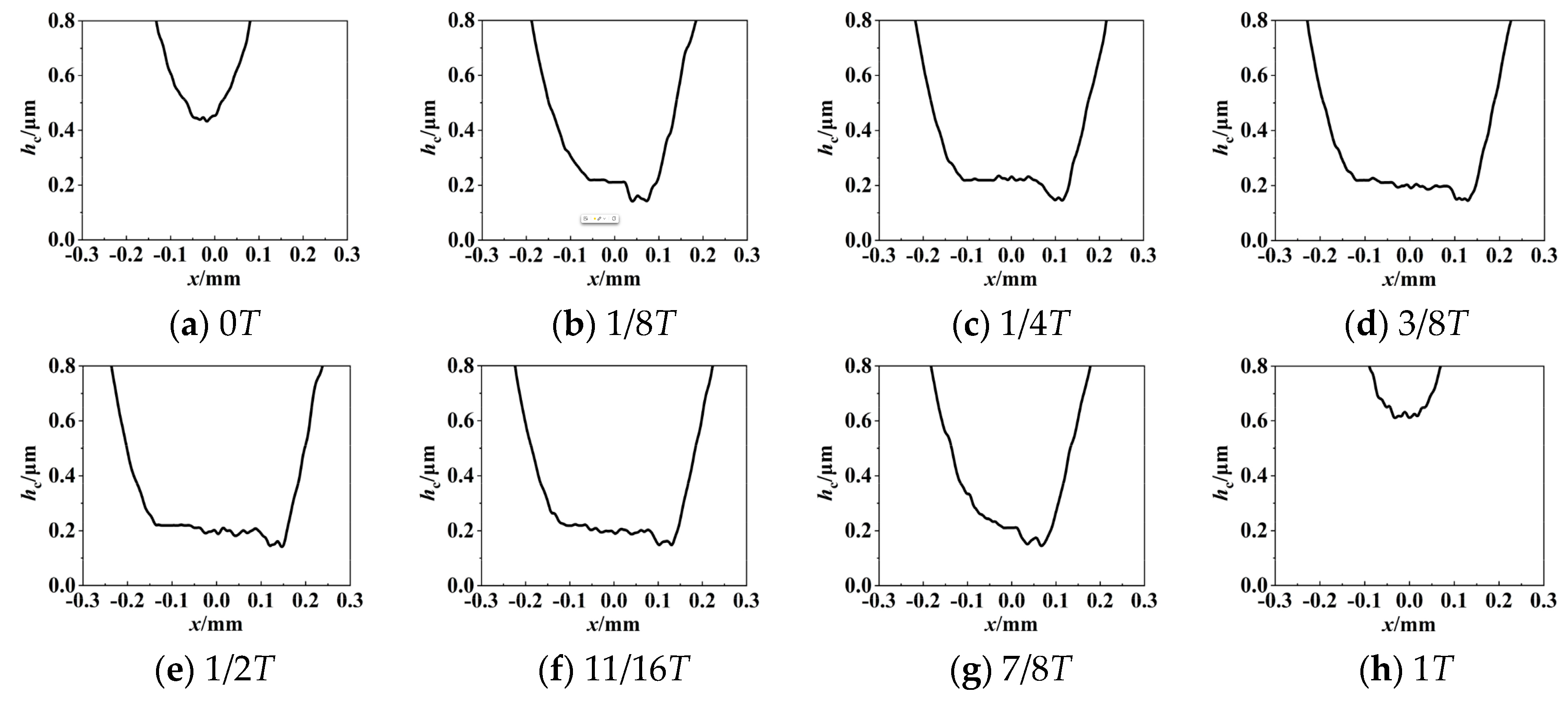
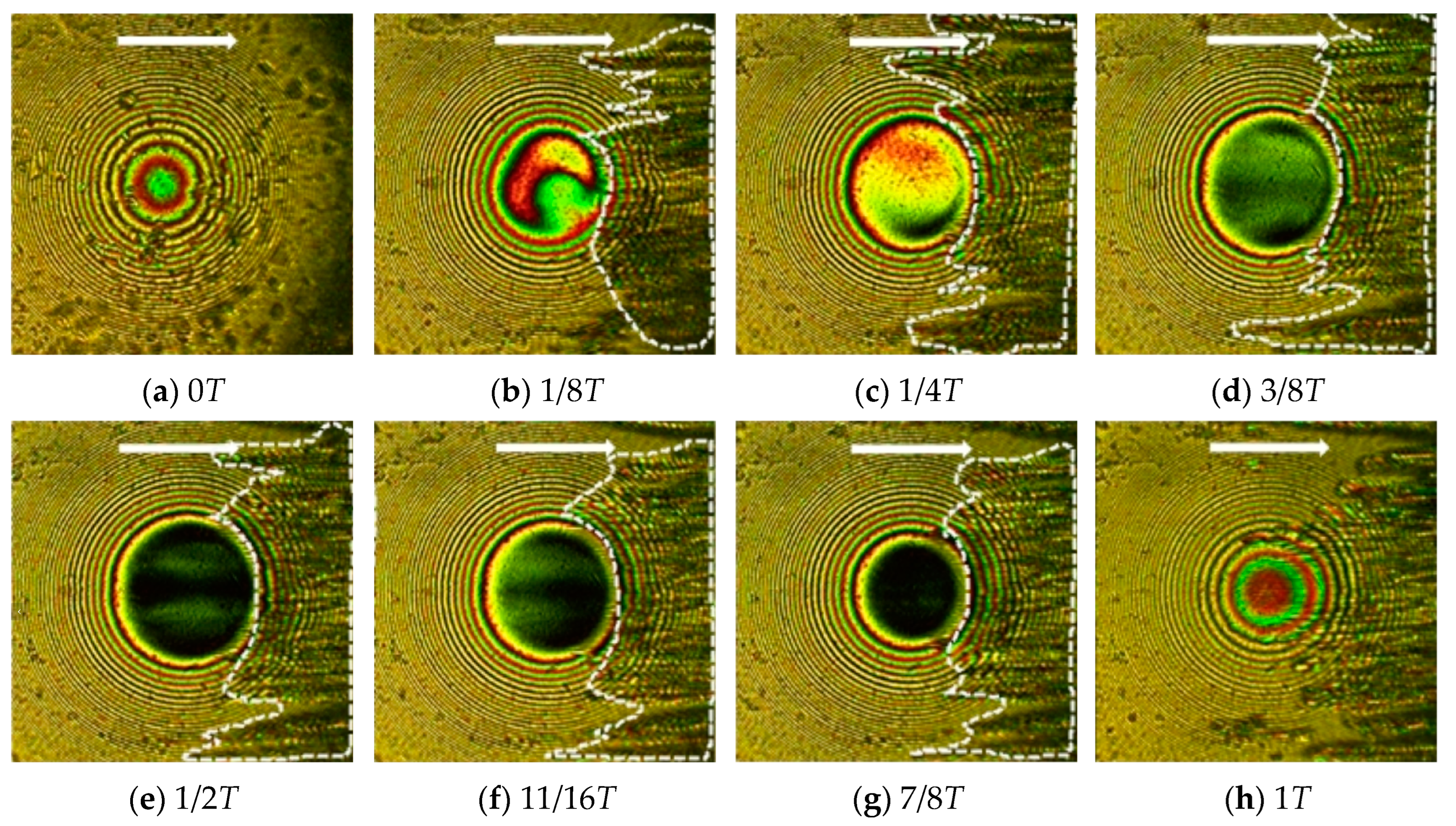
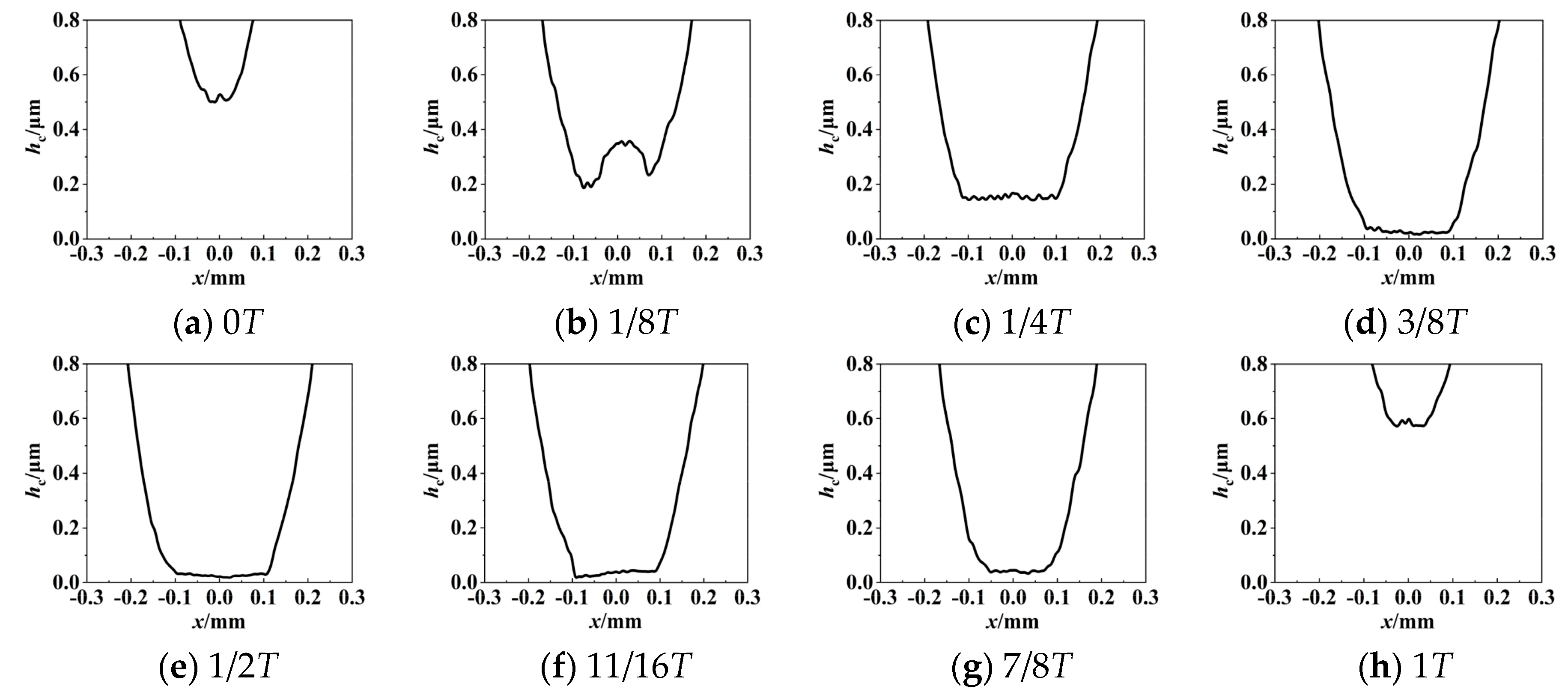

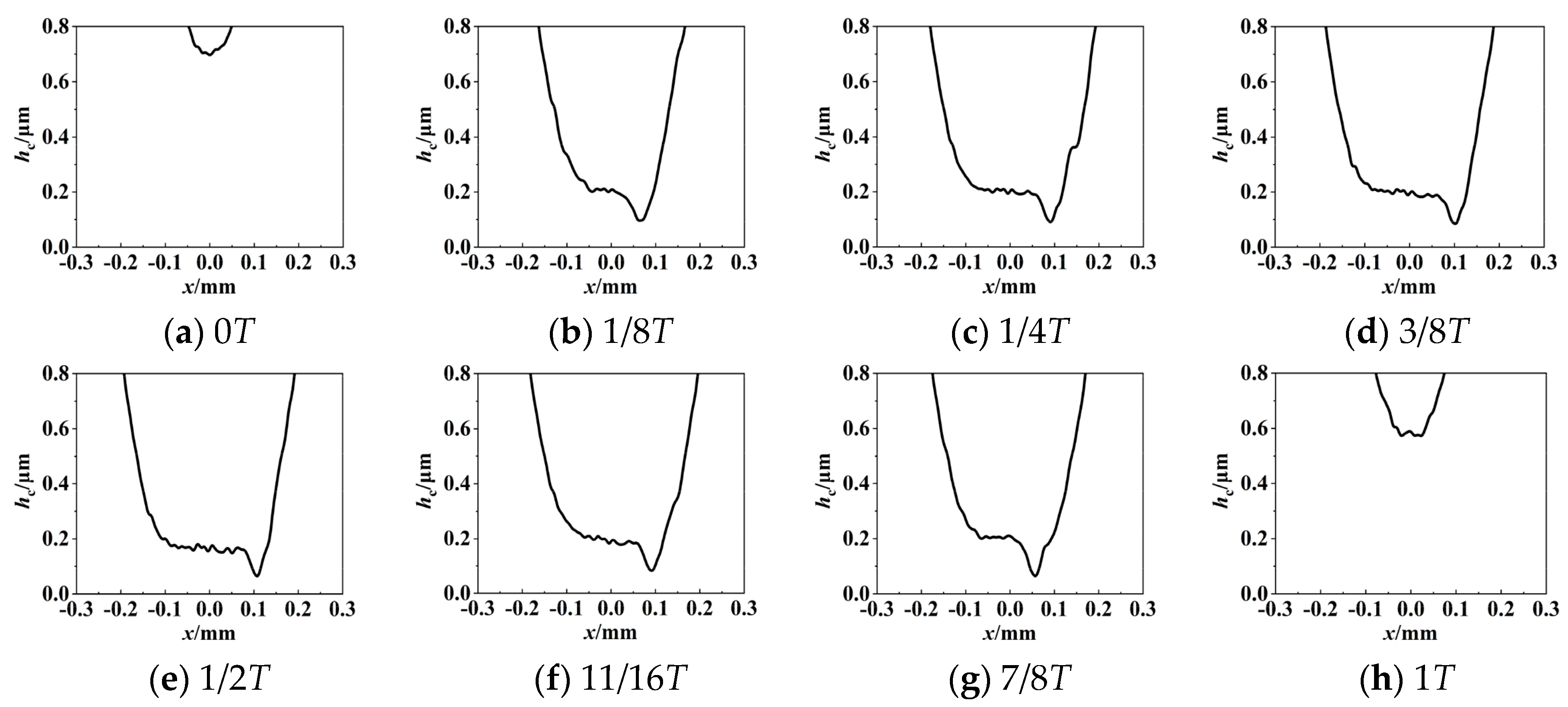


| Glass Disk | Steel Ball | |
|---|---|---|
| Material | K9 glass | GCr15 steel |
| Diameter (mm) | 150 | 25.4 |
| Thickness (mm) | 15 | |
| Elastic modulus (GPa) | 81 | 208 |
| Poisson ratio | 0.208 | 0.3 |
| Properties | YG 1 | YG 2 | YG 3 | YG 4 |
|---|---|---|---|---|
| Base oil | PAO 4 | PAO 4 | PAO 40 | PAO 40 |
| Thickener | Lithium soap | Lithium soap | Lithium soap | Lithium soap |
| Base oil viscosity (40 °C mm2/s) | 18 | 18 | 496 | 496 |
| Base oil viscosity (100 °C mm2/s) | 4 | 4 | 47 | 47 |
| Penetration (×0.1 mm) | 280–305 | 166–177 | 320–339 | 245–264 |
| NLGI | 2 | 4 | 1 | 3 |
| Experiment No. | Sliding Speed (vs/m·s−1) | Grease Type | Base Oil | Thickener Content |
|---|---|---|---|---|
| 1 | 0.01 | Yangtze Grease 1 | PAO 4 | 8% |
| 2 | 0.1 | |||
| 3 | 0.01 | Yangtze Grease 2 | PAO 4 | 16% |
| 4 | 0.1 | |||
| 5 | 0.01 | Yangtze Grease 3 | PAO 40 | 8% |
| 6 | 0.1 | |||
| 7 | 0.01 | Yangtze Grease 4 | PAO 40 | 16% |
| 8 | 0.1 |
Disclaimer/Publisher’s Note: The statements, opinions and data contained in all publications are solely those of the individual author(s) and contributor(s) and not of MDPI and/or the editor(s). MDPI and/or the editor(s) disclaim responsibility for any injury to people or property resulting from any ideas, methods, instructions or products referred to in the content. |
© 2024 by the authors. Licensee MDPI, Basel, Switzerland. This article is an open access article distributed under the terms and conditions of the Creative Commons Attribution (CC BY) license (https://creativecommons.org/licenses/by/4.0/).
Share and Cite
Wang, X.; Lv, Z.; Han, Y.; Wang, J. Effect of Grease Composition on Impact-Sliding Wear. Lubricants 2024, 12, 279. https://doi.org/10.3390/lubricants12080279
Wang X, Lv Z, Han Y, Wang J. Effect of Grease Composition on Impact-Sliding Wear. Lubricants. 2024; 12(8):279. https://doi.org/10.3390/lubricants12080279
Chicago/Turabian StyleWang, Xinqing, Zhendong Lv, Yiming Han, and Jing Wang. 2024. "Effect of Grease Composition on Impact-Sliding Wear" Lubricants 12, no. 8: 279. https://doi.org/10.3390/lubricants12080279
APA StyleWang, X., Lv, Z., Han, Y., & Wang, J. (2024). Effect of Grease Composition on Impact-Sliding Wear. Lubricants, 12(8), 279. https://doi.org/10.3390/lubricants12080279





